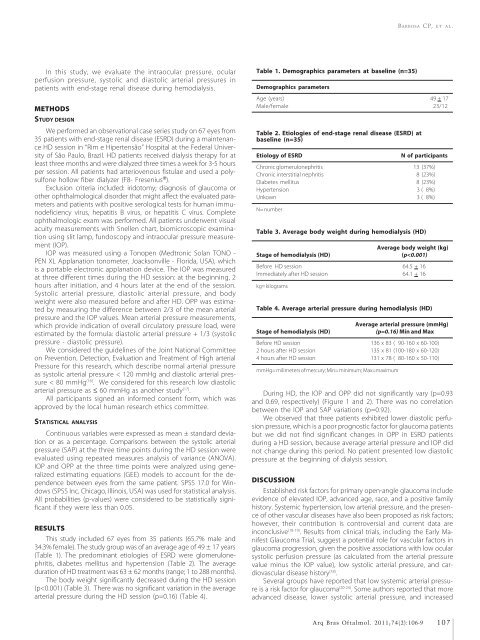a rquivos b rasileiros - Conselho Brasileiro de Oftalmologia
a rquivos b rasileiros - Conselho Brasileiro de Oftalmologia
a rquivos b rasileiros - Conselho Brasileiro de Oftalmologia
You also want an ePaper? Increase the reach of your titles
YUMPU automatically turns print PDFs into web optimized ePapers that Google loves.
BARBOSA CP, ET AL.<br />
In this study, we evaluate the intraocular pressure, ocular<br />
perfusion pressure, systolic and diastolic arterial pressures in<br />
patients with end-stage renal disease during hemodialysis.<br />
METHODS<br />
STUDY DESIGN<br />
We performed an observational case series study on 67 eyes from<br />
35 patients with end-stage renal disease (ESRD) during a maintenance<br />
HD session in “Rim e Hipertensão” Hospital at the Fe<strong>de</strong>ral University<br />
of São Paulo, Brazil. HD patients received dialysis therapy for at<br />
least three months and were dialyzed three times a week for 3-5 hours<br />
per session. All patients had arteriovenous fistulae and used a polysulfone<br />
hollow fiber dialyzer (F8- Fresenius ® ).<br />
Exclusion criteria inclu<strong>de</strong>d: iridotomy; diagnosis of glaucoma or<br />
other ophthalmological disor<strong>de</strong>r that might affect the evaluated parameters<br />
and patients with positive serological tests for human immuno<strong>de</strong>ficiency<br />
virus, hepatitis B virus, or hepatitis C virus. Complete<br />
ophthalmologic exam was performed. All patients un<strong>de</strong>rwent visual<br />
acuity measurements with Snellen chart, biomicroscopic examination<br />
using slit lamp, fundoscopy and intraocular pressure measurement<br />
(IOP).<br />
IOP was measured using a Tonopen (Medtronic Solan TONO -<br />
PEN XL Applanation tonometer, Joacksonville - Florida, USA), which<br />
is a portable electronic applanation <strong>de</strong>vice. The IOP was measured<br />
at three different times during the HD session: at the beginning, 2<br />
hours after initiation, and 4 hours later at the end of the session.<br />
Systolic arterial pressure, diastolic arterial pressure, and body<br />
weight were also measured before and after HD. OPP was estimated<br />
by measuring the difference between 2/3 of the mean arterial<br />
pressure and the IOP values. Mean arterial pressure measurements,<br />
which provi<strong>de</strong> indication of overall circulatory pressure load, were<br />
estimated by the formula: diastolic arterial pressure + 1/3 (systolic<br />
pressure - diastolic pressure).<br />
We consi<strong>de</strong>red the gui<strong>de</strong>lines of the Joint National Committee<br />
on Prevention, Detection, Evaluation and Treatment of High arterial<br />
Pressure for this research, which <strong>de</strong>scribe normal arterial pressure<br />
as systolic arterial pressure < 120 mmHg and diastolic arterial pressure<br />
< 80 mmHg (16) . We consi<strong>de</strong>red for this research low diastolic<br />
arterial pressure as ≤ 60 mmHg as another study (17) .<br />
All participants signed an informed consent form, which was<br />
approved by the local human research ethics committee.<br />
STATISTICAL ANALYSIS<br />
Continuous variables were expressed as mean ± standard <strong>de</strong>viation<br />
or as a percentage. Comparisons between the systolic arterial<br />
pressure (SAP) at the three time points during the HD session were<br />
evaluated using repeated measures analysis of variance (ANOVA).<br />
IOP and OPP at the three time points were analyzed using generalized<br />
estimating equations (GEE) mo<strong>de</strong>ls to account for the <strong>de</strong>pen<strong>de</strong>nce<br />
between eyes from the same patient. SPSS 17.0 for Windows<br />
(SPSS Inc, Chicago, Illinois, USA) was used for statistical analysis.<br />
All probabilities (p-values) were consi<strong>de</strong>red to be statistically significant<br />
if they were less than 0.05.<br />
RESULTS<br />
This study inclu<strong>de</strong>d 67 eyes from 35 patients (65.7% male and<br />
34.3% female). The study group was of an average age of 49 ± 17 years<br />
(Table 1). The predominant etiologies of ESRD were glomerulonephritis,<br />
diabetes mellitus and hypertension (Table 2). The average<br />
duration of HD treatment was 63 ± 62 months (range; 1 to 288 months).<br />
The body weight significantly <strong>de</strong>creased during the HD session<br />
(p

















